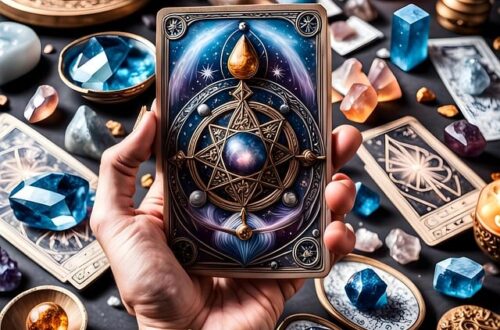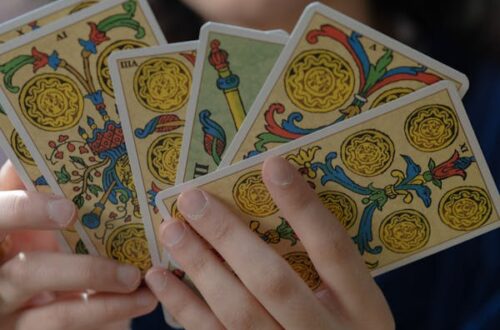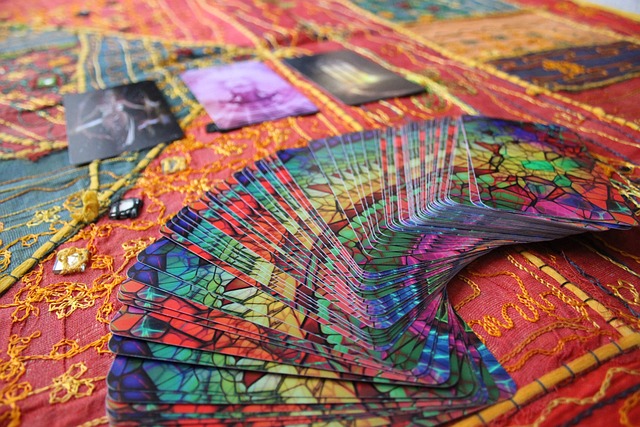
The Symbolism in Tarot: A detailed analysis
Table of Contents
The Symbolism in Tarot: A Detailed Analysis
Introduction
Tarot cards have fascinated individuals for centuries. This fascination stems from their rich symbolism and profound insights. The tarot deck comprises 78 cards, divided into the Major and Minor Arcana. Each card carries unique imagery and meanings that can be interpreted in numerous ways. Understanding the symbolism in tarot allows readers to delve deeper into their personal journeys. In this article, we will explore the intricate symbolism found within the tarot deck, focusing on the Major Arcana, the Minor Arcana, and how these symbols can be applied to various aspects of life.
The Structure of the Tarot Deck
The Major Arcana
The Major Arcana consists of 22 cards, each representing significant life lessons and spiritual themes. These cards are numbered from 0 to 21, starting with The Fool (0) and ending with The World (21). Each card serves as a milestone in the human experience, illustrating different stages of growth and understanding.
The Fool: Beginnings and Innocence
The Fool represents new beginnings and the spirit of adventure. Depicted as a young person about to step off a cliff, this card embodies the essence of taking risks. The symbolism in this card encourages us to embrace spontaneity and to trust our intuition. Furthermore, the dog at the Fool’s feet signifies loyalty and instinct, urging us to remain grounded as we explore the unknown.
For example, when The Fool appears in a reading, it may suggest that the querent is on the brink of a new journey. This could be a new job, relationship, or personal endeavor. The message encourages them to take that leap of faith, suggesting that they have the support they need, even if they cannot see it yet. Thus, The Fool embodies the courage to step into the unknown with an open heart and mind.
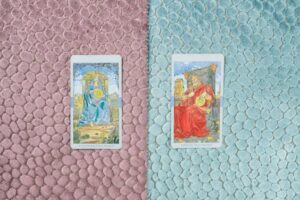
The Magician: Manifestation and Resourcefulness
Following the Fool, The Magician symbolizes manifestation and the power of creation. He stands with one hand pointing to the heavens and the other pointing to the earth. This imagery suggests the connection between the spiritual and material realms. The Magician reminds us of our ability to harness our skills and resources to achieve our desires. By channeling our willpower and focus, we can turn our ideas into reality.
When The Magician appears, it often indicates that the querent has all the tools necessary for success. The card may encourage them to tap into their creativity and resourcefulness. For instance, if someone is contemplating starting a business, The Magician suggests they are ready to take action. They must align their thoughts, intentions, and efforts to manifest their goals effectively. The card emphasizes the importance of confidence and belief in one’s abilities.
The Minor Arcana
The Minor Arcana is composed of 56 cards, which are further divided into four suits: Cups, Wands, Swords, and Pentacles. Each suit represents different aspects of life and emotions.
Cups: Emotions and Relationships
The suit of Cups is associated with emotions, relationships, and connections. Each card within this suit provides insight into our emotional state and how we interact with others. For example, the Two of Cups signifies unity and partnership. This card symbolizes the bond between two individuals, emphasizing the importance of mutual respect and love. The imagery of two cups being offered to each other illustrates the flow of emotions and the power of collaboration.
In a reading, the appearance of the Two of Cups may indicate a new romantic relationship or the strengthening of an existing one. It can also signify friendship or reconciliation. The querent may be encouraged to express their feelings openly and to embrace the emotional connection they share with others. This card often embodies the joy of shared experiences and the importance of building emotional bridges.
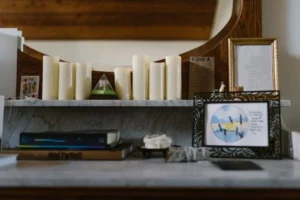
Wands: Creativity and Action
Wands represent creativity, passion, and action. This suit encourages us to pursue our ambitions and express our true selves. The Ace of Wands, for instance, symbolizes new beginnings in creative ventures. This card often appears when an individual is on the verge of a breakthrough. It reminds us to embrace our enthusiasm and take the necessary steps to bring our ideas to life.
When the Ace of Wands appears in a reading, it signifies a surge of inspiration. It may indicate that the querent has an opportunity to start a new project or pursue a passion. This card encourages them to take action and to harness their creative energy. For example, an artist may receive this card when they are about to begin a new piece, reminding them to channel their creativity and pursue their artistic vision wholeheartedly.
Swords: Intellect and Conflict
The suit of Swords embodies intellect, conflict, and decision-making. Swords are often associated with challenges and obstacles. The Three of Swords, for example, illustrates heartbreak and emotional pain. This card serves as a reminder that suffering can lead to personal growth. It encourages us to confront our fears and seek clarity in difficult situations.
When the Three of Swords appears, it often indicates emotional turmoil. The querent may be experiencing heartbreak, betrayal, or loss. This card encourages them to process their feelings and to seek healing. Although the imagery is somber, it also serves as a reminder that healing is possible. The card suggests that facing pain can lead to a deeper understanding of oneself and ultimately foster resilience and growth.
Pentacles: Material and Financial Aspects
The suit of Pentacles pertains to material wealth, career, and practicality. It reflects our relationship with the physical world. The Ten of Pentacles signifies financial stability and legacy. This card symbolizes the culmination of hard work and dedication. It encourages us to appreciate the fruits of our labor while also considering our long-term goals.
When the Ten of Pentacles appears in a reading, it often suggests that the querent has achieved a significant level of success. This may manifest as financial security, a stable home life, or a strong family legacy. The card encourages them to reflect on their accomplishments and to consider how they can contribute to future generations. For instance, it may prompt them to think about their investments, savings, or the values they wish to pass on to their children.

Detailed Symbolism Analysis
Color Symbolism in Tarot
Color plays a significant role in tarot symbolism. Each hue conveys particular meanings and can alter the interpretation of a card. For instance, red often signifies passion, energy, and action, while blue is associated with calmness, intuition, and communication. The use of these colors can influence the emotional tone of a reading.
For example, in the Two of Cups, the red of the cups symbolizes passion and deep emotional connection. In contrast, the blue sky in the background represents clarity and communication. Together, these colors convey the message that strong relationships are built on passion, mutual understanding, and open dialogue.
Numerology and Its Influence
Numerology also plays a vital role in interpreting tarot symbols. Each number carries specific vibrational qualities that influence the meaning of the cards. For instance, the number one often symbolizes new beginnings, while the number ten represents completion or fulfillment. Understanding these numerological meanings can enhance the depth of a reading.
For instance, in the Major Arcana, The Wheel of Fortune (10) signifies cycles and the inevitable changes of life. It serves as a reminder that life is ever-changing and that one must adapt to new circumstances. The presence of this card in a reading may indicate that the querent is at a turning point, encouraging them to embrace the changes that lie ahead.
The Role of Elemental Associations
Each suit in the Minor Arcana is associated with a specific element: Cups with Water, Wands with Fire, Swords with Air, and Pentacles with Earth. These elemental associations add another layer of meaning to the cards. For instance, the element of Water relates to emotions, intuition, and relationships, making it significant when interpreting the Cups suit.
The Queen of Cups, for example, embodies emotional depth and empathy. She represents a nurturing figure who is in tune with her emotions and the emotions of others. When this card appears in a reading, it often encourages the querent to trust their intuition and to seek emotional balance. The Queen of Cups reminds us of the importance of self-care and compassion in our relationships.
Interpreting Tarot Symbols
When interpreting tarot symbols, context plays a crucial role. The surrounding cards, the position in the spread, and the reader’s intuition all contribute to the overall meaning. Additionally, colors and imagery within the cards can enhance the message. For example, red often signifies passion or conflict, while blue may represent calmness and reflection. Recognizing these nuances helps create a more profound understanding of the reading.
Personal Reflection and Growth
Engaging with tarot symbols can lead to personal reflection and growth. Each reading offers an opportunity to examine our thoughts and feelings. By contemplating the imagery and meanings, we can gain insights into our current situations. This process encourages self-awareness and introspection. As a result, tarot can be a powerful tool for personal development.
The Role of Intuition
Intuition is a vital component of tarot reading. While the meanings of the cards provide a foundation, intuition allows for a personalized interpretation. Readers are encouraged to trust their instincts and feelings during a reading. This connection to intuition can lead to more meaningful insights and a deeper understanding of the symbols present in the cards.
Conclusion
The symbolism in tarot is rich and multifaceted. Each card, whether from the Major or Minor Arcana, offers profound insights into the human experience. By exploring the imagery and meanings, we can gain a better understanding of ourselves and our journeys. Tarot serves as a mirror, reflecting our thoughts and emotions while guiding us toward personal growth. As we engage with the symbols, we unlock the potential for transformation and self-discovery.
Bibliography
- Greer, Mary K. The Complete Book of Tarot Reversals. Weiser Books, 2002. ISBN: 978-1578632311
- Hajo, Z. The Tarot: History, Symbolism, and Divination. Princeton University Press, 2009. ISBN: 978-0691139038
- Pollack, Rachel. 78 Degrees of Wisdom: A Tarot Journey to Self-Awareness. Weiser Books, 2016. ISBN: 978-1578635619
- DuQuette, Lon Milo. The Key to Tarot. Weiser Books, 1998. ISBN: 978-1578630058
- Kaplan, Stuart R. The Encyclopedia of Tarot, Volume 1. U.S. Games Systems, 1986. ISBN: 978-0913866861
- Decker, Ronald, and Eden Gray. The Tarot: A Key to the Wisdom of the Ages. Insight Editions, 2021. ISBN: 978-1681983731
- Rider, Waite. The Pictorial Key to the Tarot. Rider & Company, 1910. ISBN: 978-0712659207
- Schwarz, Franz. Tarot Symbols: A Handbook. Destiny Books, 2015. ISBN: 978-1620552503


